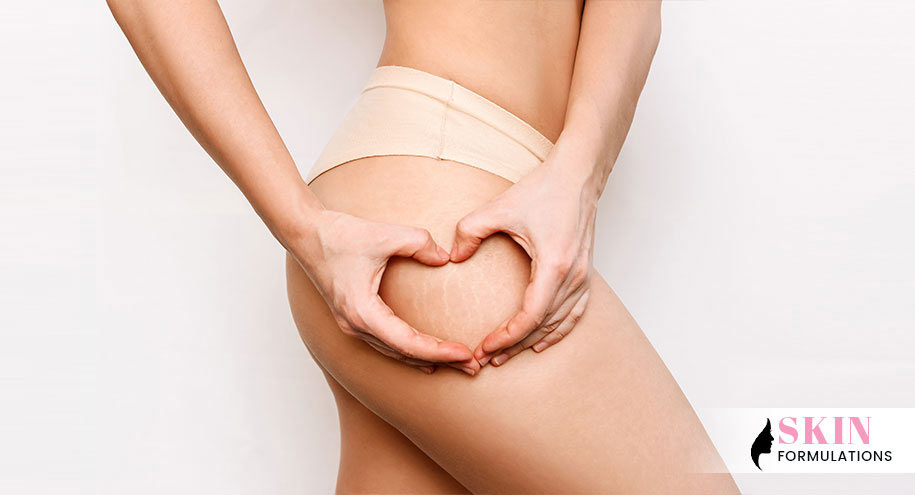Stretch Marks – Causes, Treatments, And How to Prevent Them

Introduction
Stretch marks, also known medically as striae, are very common, especially during puberty and pregnancy, and usually appear as lines on the stomach, breasts, hips, butt, or thighs. While stretch marks are not harmful to your health, they can affect your confidence and make you feel self-conscious about your body. If you’re looking to reduce the appearance of stretch marks or prevent them in the first place, we’ve got some great tips for you – so read on!
What Causes Stretch Marks?
Stretch marks happen when the dermis (middle layer of skin) is stretched beyond its capacity, causing the collagen and elastin fibers that give your skin its strength and elasticity to break down. This can occur during times of growth spurts, such as in puberty, periods of weight gain, including pregnancy, or when the muscle is built up very quickly through weight training. However, other causes can include skin conditions, the use of certain medications, medical procedures, aging, and sun exposure. While they can appear on any part of the body, as noted above, stretch marks typically show up on the stomach, breasts, hips, butt, and thighs.
Are There Any Treatments or Home Remedies for Stretch Marks?
While there is no guaranteed cure for stretch marks, there are some treatments that may help to minimize their appearance –
- Aloe Vera gel is known for its healing properties and can be applied to soothe and moisturize the skin, helping to reduce the appearance of stretch marks.
- Hyaluronic acid is a popular skincare ingredient that helps keep the skin hydrated and plump, with a fuller appearance that can minimize the severity of stretch marks.
- The herb Centella Asiatica has been traditionally used to treat stretch marks, and there is evidence to show that this ingredient may reduce their development.
- Laser skin resurfacing, dermabrasion and micro-needling are all procedures that can help improve the appearance of the skin where stretch marks occur, by stimulating collagen production and increasing cell turnover.
- Retinol is a vitamin A derivative that has many benefits for the skin when applied topically and may help reduce the severity of stretch marks by increasing collagen production.
In some cases, individuals may opt for surgery to remove particularly large or deep stretch marks, but if you’re unsure about which method will work best for you, talk to a doctor or dermatologist to get an expert opinion.
How Can You Prevent Stretch Marks?
There are several things you can do to help prevent stretch marks from developing in the first place –
- Because they are more likely to occur if you gain weight quickly, try to avoid putting on extra pounds by following a healthy diet plan and getting regular exercise. If the weight gain is from pregnancy, keeping the skin well moisturized always will significantly reduce the risk of developing severe stretch marks.
- In addition to weight management, a diet that’s high in vitamins and minerals will help keep your skin healthy from within and therefore less likely to develop stretch marks. Be sure to eat plenty of fruits, vegetables, and whole grains, and include lean protein in your diet to support the production of collagen and improve your skin’s elasticity.
- Dry skin is more likely to develop stretch marks, and while there’s no direct evidence to show that drinking water prevents them, ensuring you’re well-hydrated may help keep your skin soft and supple, while improving its overall appearance.
- While there are numerous reasons to quit smoking, this unhealthy habit will damage the fibers in your skin, causing loss of elasticity and thereby making you more susceptible to developing stretch marks.
- It’s not only during pregnancy that you should use a topical cream or lotion to keep stretch marks at bay. Although there is no scientific evidence to show that these products work, some people find that massaging the skin with those containing vitamin E, vitamin C, or cocoa butter will reduce the chance of developing stretch marks at any time.
Conclusion
Even though stretch marks are common and won’t negatively impact your health, many people consider them unsightly and, as a result, want to get rid of them! Whether you’re pregnant, going through puberty, are weight training, or even taking a medication that may make you more susceptible to developing stretch marks, being proactive by following the tips above may certainly help prevent them. If, however, you have existing stretch marks that you want to get rid of, you can minimize their appearance by using targeted topical creams or talking to a skincare professional about your treatment options.
Thanks for reading!
Deprecated: Function WP_Query was called with an argument that is deprecated since version 3.1.0!
caller_get_posts is deprecated. Use ignore_sticky_posts instead. in /home/healthwebmagazin/skinformulations.com/wp-includes/functions.php on line 5737






